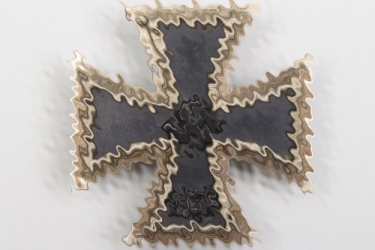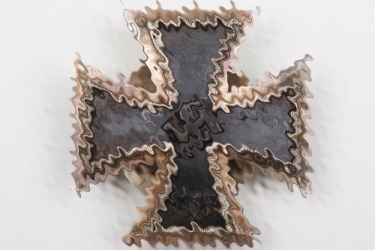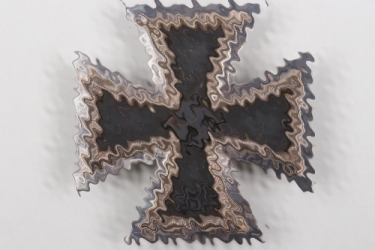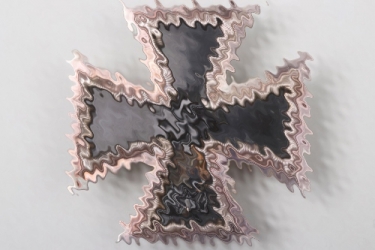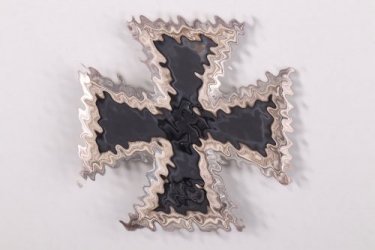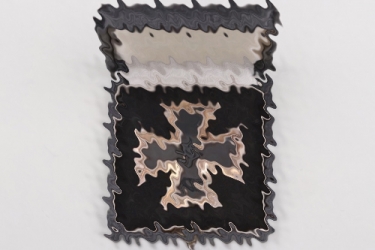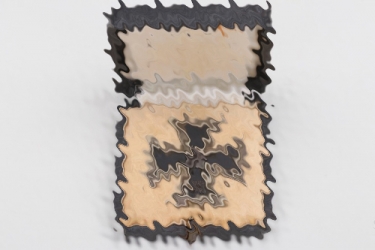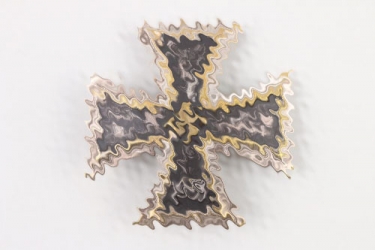61st Contemporary History Auction
Catalogue updated on a daily basis
U-458 Kptlt. Kurt Diggins - 1939 Iron Cross 1st Class "Deumer"
USD 221,62
Own a similar product you want to sell? We are here for you at +49 8541 9053699
-
PAYMENT
-
HOW CAN I PAY FOR MY ORDER?
AUCTIONSYou will receive an e-mail confirming your successful bids the day after the auction has ended. In your personal my ratisbon's you will be able to inform us about your most convenient payment method for this order or tell us about an alternative shipping address.
If we don’t hear from you within 24 hours, we will send an invoice choosing the payment and shipping options which we think are the most comfortable ones to you. If you decide to change your shipping or payment method after receiving your invoice, just drop us a line or visit my ratisbon's/ORDERS for any more details.
SHOP ORDERSChoose your payment method when ordering and submit your order. Once your order has been received we will send an invoice including your shipping costs and your payment instructions.
After receiving the invoice, the order must be paid within 7 days.
Please contact us to discuss layaway options.To learn more about paying at ratisbon's, please see your FAQ pages.
WE ACCEPT FOLLOWING PAYMENT METHODS
-
-
Versand
-
HOW DO YOU SHIP MY NEW TREASURES?
PACKING & TRACKINGWe usually send out orders within 1-3 working days after your payment has been received. In most cases, we are faster than this! We will inform you when your goods are being dispatched and provide a tracking number, In addition, you can always check your order status at my ratisbon's/ORDERS. Delivery times will vary depending upon the delivery destination and type of shipping service you have chosen.
SHIPPING TO ALTERNATIVE ADDRESSIf you prefer to have your order shipped to your work address or a friend during your absence, we will happy to arrange this for you. Send us an email letting us know about your new shipping address and we will be happy to send an updated invoice to you.
OUR LOGISTIC PARTNERS ARE AS FOLLOWS
-
-
OUR GUARANTEE
-
 OUR GUARANTEE!
OUR GUARANTEE!We only offer collectables which to the best of our specialists knowledge are authentic. About 15% of all consignments are returned to the consignor after extensive research due to authenticity issues.
Unlike traditional auction houses we do offer a full right of return. If you are not satisfied with what you won or bought, you may return it within 14 days. Please inform us and we will instruct you on how to return the goods. For more information, please visit FAQ pages.
Important note: Cancelling bids after an auction may disappoint the consignor, who like you is a collector. This situation is easy to avoid. We encourage you not to bid on any collectable if you are unsure if it fits into your collection. Ask us to cancel your bid 24 hours prior to the end of an auction to avoid this situation.
-
COUNTRY Germany 1918 - 1945
DIMENSIONS
WEIGHT
EAN 2000000879536
PERIOD 1918 — 1945
COUNTRY Germany 1918 - 1945
MATERIAL
DIMENSIONS
MAKER Wilhelm Deumer
WEIGHT
COUNTRY Germany 1918 - 1945
LOT 76-1453
DIMENSIONS
EAN 2000000879536
MAKER Wilhelm Deumer
WEIGHT
Description
All items from the estate of Lieutenant Commander Kurt Diggins (Crew 34). Diggins sunk two ships and had seven patrols. He is known (postwar) for a very famous propaganda photo you can find here: https://uboat.net/men/commanders/205.html
Kurt Diggins was born on October 17, 1913, in Gut Mohrberg, then part of Kreis Eckernförde in the Prussian Province of Schleswig-Holstein. Today, this area is part of Barkelsby, located in the district of Rendsburg-Eckernförde, in the federal state of Schleswig-Holstein. He passed away at the age of 93 on March 1, 2007, in Bonn, a city in the Cologne administrative district of North Rhine-Westphalia.
Kurt Diggins began his naval career on April 8, 1934, when he entered the Reichsmarine as a naval officer cadet, having previously served as a merchant ship officer (Handelsschiffsoffizier). He was integrated into the "Crew 35." His initial training took place from April to June 1934 at the 2nd Division of the Baltic Sea Ship Training Division in Stralsund. Following his basic training, he underwent shipboard training aboard the sailing training ship Gorch Fock from June to September 1934, and then on the light cruiser Karlsruhe until June 1935.
He completed further officer training at the Naval Academy in Flensburg-Mürwik from June 1935 to March 1936, including a main course for cadets and the final officer’s examination. After completing additional training courses through September 1936, Diggins’ specific activities between October 1936 and April 1939 remain unrecorded. However, by April 1939, he was serving as adjutant aboard the armored cruiser Admiral Graf Spee, a position he held until the ship's loss off Montevideo on December 17, 1939.
Following the loss of the Admiral Graf Spee, Diggins, along with other crew members, was interned in Montevideo, Uruguay, from December 1939 to July 1940. Upon his return to Germany, he was placed at the disposal of the North Sea Station Command. Between September and December 1940, Diggins assumed command of the 6th Minesweeper Flotilla, followed by command of the 5th Minesweeper Flotilla until March 31, 1941.
In April 1941, Diggins began U-boat training at the 1st U-Boat Training Division in Pillau. This was followed by torpedo and communications training in Flensburg-Mürwik, as well as further U-boat training at Neustadt. By October 1941, he had completed his commanding officer training and live firing exercises at the 24th U-Boat Flotilla in Memel.
On November 16, 1941, Diggins began preparations for the construction of U-458 at the 1st Warship Construction Division in Kiel. He assumed command of U-458, a Type VIIC U-boat, on December 12, 1941, and commanded it until August 22, 1943. During his tenure as commander, U-458 undertook several patrols, including missions in the North Atlantic, along the U.S. East Coast, and in the western Mediterranean. Notably, on a patrol from June 21 to August 27, 1942, U-458 sank two ships totaling 7,584 GRT off the coast of Nova Scotia.
U-458 also participated in various operations in the Mediterranean, including engagements near the Algerian coast and south of Sicily. However, on August 22, 1943, U-458 was lost in the Mediterranean southeast of Pantelleria.
Following the loss of his U-boat, Kurt Diggins was taken as a British prisoner of war and was held from August 22, 1943, to September 5, 1947. He was imprisoned in Egypt and later in England at Camp 18, Featherstone Park in Haltwhistle.
Throughout his career, Diggins received several notable awards and honors. On November 10, 1940, he was awarded the Iron Cross 2nd Class, followed by various distinctions, including the War Badge for Minesweepers, Submarine Hunting, and Escort Forces in March 1941, the Fleet War Badge in July 1941, and the U-Boat War Badge in October 1942. In March 1943, he received the Iron Cross 1st Class, and on August 16, 1943, he was honored with the Bronze Medal for Military Valor from Italy.
Kurt Diggins reached the rank of Fähnrich zur See on July 1, 1935, Oberfähnrich zur See on January 1, 1937, Leutnant zur See on April 1, 1937, Oberleutnant zur See on April 1, 1939, and Kapitänleutnant on January 1, 1942. His long and eventful military career saw him serve in various capacities, from command aboard the Admiral Graf Spee to leading U-boat missions across the Atlantic and Mediterranean.
Kurt Diggins lived a long life, passing away on March 1, 2007, in Bonn. His legacy is marked by his service during some of the most challenging naval campaigns of the Second World War.
Directly from the estate of Kurt Diggins comes this Iron Cross 1st Class. Manufactured by W. Deumer from Lüdenscheid and properly maker- marked with the maker's LDO code L/11. Overall in close to mint condition.
Condition
1
NAME
Order of the Iron Cross 1. Class
DATE OF INSTITUTION
1. September 1939 as the second grade of the re-instituted Order of the Iron Cross
AWARD CRITERIA
The Iron Cross was awarded for particular bravery in the face of the enemy and for outstanding merit in troop leadership. The awarding of a higher grade required the previous awarding of the lower grade. Divisional commanders were authorized to award the Iron Cross 1. Class and stocks were kept at divisional level.
MANUFACTURERS
The Iron Cross 1. Class was produced by at least 26 manufacturers, not including variations amongst the individual companies. The crosses can be found either unmarked, with Präsidialkanzlei number (after the end of 1942 / early1943), or with LDO number for private purchase.
AWARD NUMBERS
Accurate numbers are not known but the closest estimation is around 800,000 - 900,000 awarded and most likely double the number produced.
AWARD DOCUMENTS
The division issued the award document in the format A5 in the name of the Führer and Supreme Commander of the Wehrmacht (after mid-1943 only in the name of the Führer) and was signed by the divisional commander.
WEARING METHOD
The cross was worn on the left breast pocket above any Wound Badge and war badges.









